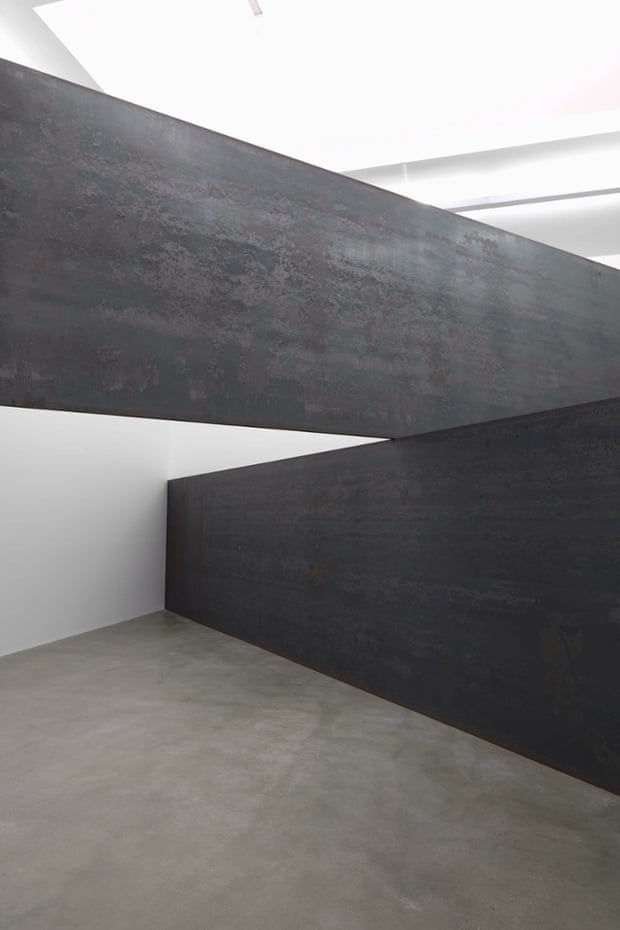
An ensemble of four very different works, with a room devoted to each, fills Gagosian in London, in Richard Serra’s first show of sculpture here since 2008. The sum is bigger than the parts, though each work is satisfying in its own way, and each is worth the trip alone. “I wanted to make a show with different aspects of compression and circulation, intervals and elevation, different ways to approach a field or a space or a context,” the 74-year-old artist tells me, speaking from New York.
Serra’s art, mostly using forged and rolled steel, has marched the length of the Grand Palais in Paris, controversially divided a New York Plaza in two and filled Frank Gehry’s Guggenheim museum. Each work here demands different things of us. Here are works to look at, to cower beneath, to wander through, to experience both as object and place. Like almost no-one else, Serra grounds us in the here and now.
One room contains two massive pieces of forged steel, one resting on top the other, the upper solid block a few inches wider and longer than the one below. My eye snags on the overhang. The blocks are a bit uneven, and don’t sit exactly flat on each other, and there are places where the light and air get between them, implying movement. These slight variations make the blocks seem like bodies themselves, slowly fucking, gravity holding them immovable but never inert. The lower block has a greyer sheen, the upper, more rusted. The top surface is around eye-height for an average person, and is at the exact same height as the base of the windows facing the street.

“Dead Load goes back to Pessoa,” says Serra. “They are almost memento mori.” Last year Serra made another twinned pair of sculptures very like Dead Load, called Grief and Reason. It was dedicated to Walter de Maria, the American artist famous for his Lightning Field, who had just died. “With Dead Load I was trying to get to the essence of something – without getting highfalutin – to do with one’s existence in terms of the experience of looking at a work of art. They are to do with the singular, internal and contemplative. The upper piece almost levitates. When you forge steel you can never get two faces completely tight and flat. It’s as if they’ve settled on one another like ancient rocks.”
A high wall of steel runs from corner to corner, running above head height of another room, dividing it. Wedged between the other two corners is another, similar sheet of steel, resting on top of the first sheet at the room’s midpoint, forming an X. The lower wall is taller than I am, and I can walk, with some hesitation, beneath the upper sheet. You feel the weight of the steel above you. The whole thing is wedged into the space. Somehow I want someone else to be on the other side of the wall, in the other half of the room.
A larger gallery is filled with upright slabs, some longer, some shorter, of varying heights arranged in 12 rows. Over 100 metric tons of steel almost fill the space. “You can almost feel the density of it behind your knees!” Serra exclaims. The rows run parallel to the gallery’s longer walls, lining up alternately from the left and right sides of the gallery. “You have to stay with it for a while to work out the logic of the placement and size of the blocks. I don’t know if that matters in the end. In order to get to an experience I would like others to have, there has to be a subtext and a logic. The work coalesces in ways that if it were arbitrary, it would not,” Serra explains. “It is a syntax.” You can sense that there is a system as you ramble amongst and between the slabs, sidling through gaps and planes and edges. The room is full of false horizons and collapsed distances.
Backdoor Pipeline, in the final room, is a curving tunnel, around 50 feet long, each arch-like entrance invisible to the other. A path runs through it. Serra describes the geometry of the convex and concave curves. “Basically it’s a doughnut. The inside is a doughnut with a reverse curve and the outside is a section of a sphere,” he says. He sends me a scan of a drawing to explain. “It took three years to build and took about 60 people to put it together.” Walking through the sculpture, I wonder if Jonah appreciated the play of light and dark and the complex geometries as he slid down the gullet of the whale.
The sculpture is a wondrous thing. Serra describes how difficult it was to make. “The company lost money on it. They make nose-cones and ships, as well as a lot of my work. It got very complicated and they had to remake half of it. Everyone at the company got into it.” Me too. Serra’s art always reminds us that we are bodies in space, that space is curved, that gravity always claims us. Feel the weight.

No hay comentarios:
Publicar un comentario